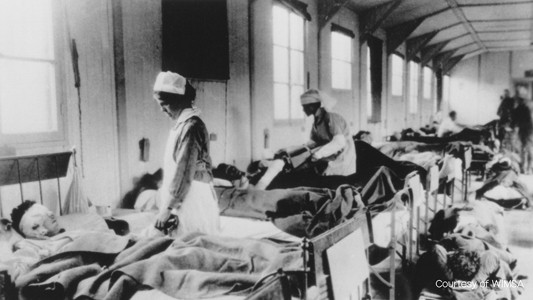A Storyteller’s Memorial
Amid the horrors of World War I, battlefield nurses were angels of mercy. America’s battered and beleaguered doughboys knew that for certain, and you will, too, after listening to Maryland storyteller Ellouise Schoettler recount Ready to Serve: Unknown Stories of 64 World War I Nurses from Maryland.
The town of Chesapeake Beach takes Memorial Day seriously, with this year’s Stars & Stripes Festival commemorating the centennial of The War to End All Wars, the most substantial yet. Schoettler’s stories and slide presentation combine with three days of patriotic honors, music, an American Legion picnic, outdoor fun and a hefty dose of patriotism and local pride.
“My love of genealogy led me into storytelling,” says Schoettler, who has spent more than 30 years seeking forgotten stories of everyday women, then painting pictures of their lives using only the spoken word. “I see my family tree as scaffolding. But I always try to flesh it out with stories.”
|
“I wanted to give these women a voice and give credit where credit is due,” says storyteller Ellouise Schoettler, who has woven stories from the letters of Johns Hopkins nurses serving in World War I. |
Schoettler heard her first storyteller years ago in a church basement. She was hooked. “That night,” she says, “I decided I was going to do that, and people are going to listen.”
She did, and they have.
In the early 1950s, Schoettler left her native North Carolina for nursing training at Johns Hopkins University Hospital. Love and marriage intervened. Later she earned an art degree.
As an Air Force doctor’s wife and mother of four, she moved around the world, learning to appreciate the sacrifice of service members and their families. Once her children were grown, she launched her career as a storyteller.
About four years ago, with the 100th anniversary of the Great War upon us, Schoettler began scouting for stories about women’s contributions to the war effort. At the Chesney Medical Library on the Johns Hopkins Medical Campus, she stumbled upon a treasure: 57 letters sent from France by a deployed unit of 64 World War I nurses, all graduates of the Johns Hopkins School of Nursing in Baltimore.
Schoettler was ecstatic.
Nurses for the War
In 1916, the U.S. was in preparation for war. Among many shortages was Army nurses. The Nurse Corps for women had been established in 1901, and nurses joined up for three years. Other nurses willing to serve were on standby. Working with the American Red Cross, Congress established moveable units of nurses, women willing to mobilize when called to serve.
On April 6, 1917, America entered World War I. Congress issued a call for a nursing support unit to reach France with the first division of American troops. Johns Hopkins Base Hospital Unit No.18 was the only unit ready to mobilize.
In June 1917, the 64 Hopkins nurses caped in the blue of the American Red Cross boarded the USS Finland in New York City. Arriving in France, they shed their Red Cross uniforms for Army uniforms.
There were problems. Nurses from Hopkins and other units soon to arrive had no formal rank system. Not until 1947 would Army nurses be commissioned as officers. On the Hopkins team, only Chief Nurse Bessie Baker had authority.
Living conditions were rough, but the nurses settled into a boys’ dormitory and got to work. Initially, they cared for sick soldiers. Then the weather turned. Medicines froze. Soldiers died, as did several nurses. By spring of 1918, the sheer volume of wounded and dying soldiers tested the nurses’ endurance. Still, they cared for “their boys” until after the war’s end, when the unit returned Stateside.
Telling Their Stories
How could Schoettler, an 80-year-old storyteller, bring to life the stories of Army nurses, women from 25 to 45? She developed a character, an 80-year-old veteran, who reminisces about her wartime service in France with Johns Hopkins Base Hospital No. 18. Into this performance she has woven stories from the nurses’ letters. The result is a close-up of life in a battlefield hospital.

The stories are poignant, speaking of homesickness and anguish. Yet shining through is the tenacity of the human spirit. Take the Christmas of 1917, when Christmas trees were set up in a field hospital. Their only ornaments were origami stars made out of candy wrappers by the nurses.
Now, one hundred years after the arrival of the Hopkins nurses in France, Schoettler travels the country, bringing into focus this long-overlooked slice of American history.
“I wanted to give these women a voice,” she reflects, “and give credit where credit is due.”
Saturday, May 27: Storyteller Ellouise Schoettler presents Ready to Serve — WWI: Everyday life in a Battlefield Hospital, 10am at the Stars & Stripes Festival, Veterans’ Memorial Park, Routes 260 and 261, Chesapeake Beach: www.wwonenurses.weebly.com
